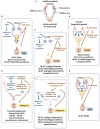What Does AMH Tell Us in Pediatric Disorders of Sex Development?
- PMID: 33013698
- PMCID: PMC7506080
- DOI: 10.3389/fendo.2020.00619
What Does AMH Tell Us in Pediatric Disorders of Sex Development?
Abstract
Disorders of sex development (DSD) are conditions where genetic, gonadal, and/or internal/external genital sexes are discordant. In many cases, serum testosterone determination is insufficient for the differential diagnosis. Anti-Müllerian hormone (AMH), a glycoprotein hormone produced in large amounts by immature testicular Sertoli cells, may be an extremely helpful parameter. In undervirilized 46,XY DSD, AMH is low in gonadal dysgenesis while it is normal or high in androgen insensitivity and androgen synthesis defects. Virilization of a 46,XX newborn indicates androgen action during fetal development, either from testicular tissue or from the adrenals or placenta. Recognizing congenital adrenal hyperplasia is usually quite easy, but other conditions may be more difficult to identify. In 46,XX newborns, serum AMH measurement can easily detect the existence of testicular tissue, leading to the diagnosis of ovotesticular DSD. In sex chromosomal DSD, where the gonads are more or less dysgenetic, AMH levels are indicative of the amount of functioning testicular tissue. Finally, in boys with a persistent Müllerian duct syndrome, undetectable or very low serum AMH suggests a mutation of the AMH gene, whereas normal AMH levels orient toward a mutation of the AMH receptor.
Keywords: Klinefelter syndrome; Leydig cell; Sertoli cell; Turner syndrome; gonadal dysgenesis; ovary; persistent Müllerian duct syndrome; testis.
Copyright © 2020 Josso and Rey.
Figures






Similar articles
-
Testicular anti-Müllerian hormone: clinical applications in DSD.Semin Reprod Med. 2012 Oct;30(5):364-73. doi: 10.1055/s-0032-1324719. Epub 2012 Oct 8. Semin Reprod Med. 2012. PMID: 23044872 Review.
-
Importance of Serum Testicular Protein Hormone Measurement in the Assessment of Disorders of Sex Development.Sex Dev. 2018;12(1-3):30-40. doi: 10.1159/000479572. Epub 2017 Aug 30. Sex Dev. 2018. PMID: 28850950 Review.
-
Evaluation of gonadal function in 107 intersex patients by means of serum antimüllerian hormone measurement.J Clin Endocrinol Metab. 1999 Feb;84(2):627-31. doi: 10.1210/jcem.84.2.5507. J Clin Endocrinol Metab. 1999. PMID: 10022428
-
Serum anti-Müllerian hormone concentration as a diagnostic tool to identify testicular tissue in canine disorders of sexual development.Domest Anim Endocrinol. 2022 Jan;78:106654. doi: 10.1016/j.domaniend.2021.106654. Epub 2021 Jul 31. Domest Anim Endocrinol. 2022. PMID: 34509739
-
Anti-müllerian hormone: a valuable addition to the toolbox of the pediatric endocrinologist.Int J Endocrinol. 2013;2013:674105. doi: 10.1155/2013/674105. Epub 2013 Dec 8. Int J Endocrinol. 2013. PMID: 24382961 Free PMC article. Review.
Cited by
-
Role of NR5A1 Gene Mutations in Disorders of Sex Development: Molecular and Clinical Features.Curr Issues Mol Biol. 2024 May 9;46(5):4519-4532. doi: 10.3390/cimb46050274. Curr Issues Mol Biol. 2024. PMID: 38785542 Free PMC article. Review.
-
Investigating the Characteristics of Pelvic Ultrasound in Girls With Their First Menstrual Cycle: A Two-Center Cross-Sectional Study.Health Sci Rep. 2025 Jun 30;8(7):e70961. doi: 10.1002/hsr2.70961. eCollection 2025 Jul. Health Sci Rep. 2025. PMID: 40599418 Free PMC article.
-
A case of 46,XY complete gonadal dysgenesis with a novel missense variant in SRY.Clin Pediatr Endocrinol. 2023;32(4):235-238. doi: 10.1297/cpe.2023-0032. Epub 2023 Sep 8. Clin Pediatr Endocrinol. 2023. PMID: 37842143 Free PMC article.
-
Categorization of differences of sex development among Egyptian children and the role of antimullerian hormone and inhibin B.Front Endocrinol (Lausanne). 2023 Jan 6;13:1072399. doi: 10.3389/fendo.2022.1072399. eCollection 2022. Front Endocrinol (Lausanne). 2023. PMID: 36686446 Free PMC article.
-
The Risk of Malignant Degeneration of Müllerian Derivatives in PMDS: A Review of the Literature.J Clin Med. 2023 Apr 25;12(9):3115. doi: 10.3390/jcm12093115. J Clin Med. 2023. PMID: 37176556 Free PMC article.
References
Publication types
MeSH terms
Substances
LinkOut - more resources
Full Text Sources

